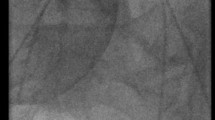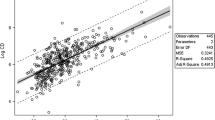Abstract
Purpose
The purpose of the study was to estimate the absorbed dose (AD) to the fetus for pregnant patients with placenta accreta undergoing fluoroscopy imaging during prophylactic catheterization and uterine artery embolization. We hypothesize that after optimizing the use of the radiation, this endovascular method is safe.
Methods
Catheterization was performed for seven women before their elective cesarean section. The correct position of the catheter was confirmed by a radiologist using a small bolus of contrast medium and optimized pulsed fluoroscopy imaging. For the AD measurements of the fetus, four radiophotoluminescence dosimeters were placed in the vaginal fornix. Dose area product (DAP), entrance skin exposure (ESE), fluoroscopy time (Tf), and dose rate also was recorded.
Results
The mean values of the radiation exposure for the seven patients were as follows: AD in the vaginal fornix was 11.2 (range 2.2–28.7) mGy, DAP 1,122 (648–2,001) cGy cm2, ESE 120 (63–184) mGy, Tf 7:31 (5:05–11:35) min:sec, and dose rate 15 (8–21) mGy/min, respectively.
Conclusions
This study revealed that the AD to the fetus due to the endovascular method can be reduced to be below the risk for developmental disorders when pulsed fluoroscopy with an optimized protocol is used without angiography exposures.





Similar content being viewed by others

Abbreviations
- DAP:
-
Dose area product
- ESE:
-
Entrance skin exposure
- AD:
-
Absorbed dose
- Tf :
-
Fluoroscopy time
- LIH:
-
Last image hold
- SID:
-
Source to image-receptor distance
- FSD:
-
Focus to skin distance
- RPLD:
-
Radiophotoluminescence dosimeter
- ICRP:
-
International Commission on Radiological Protection
References
Hansch E, Chitkara U, McAlpine J, El-Sayed Y, Dake MD, Razavi MK (1999) Pelvic arterial embolization for control of obstetric hemorrhage: a five-year experience. Am J Obstet Gynecol 180:1454–1460
Ojala K, Perälä J, Kariniemi J, Ranta P, Raudaskoski T, Tekay A (2005) Arterial embolization and prophylactic catheterization for the treatment for severe obstetric hemorrhage. Acta Obstet Gynecol Scand 84:1075–1080
Shim JY, Yoon HK, Won HS, Kim SK, Lee PR, Kim A (2006) Angiographic embolization for obstetrical hemorrhage: effectiveness and follow-up outcome of fertility. Acta Obstet Gynecol 85:815–820
Uchiyama D, Koganemaru M, Abe T, Hori D, Hayabuchi N (2008) Arterial catheterization and embolization for management of emergent or anticipated massive obstetrical hemorrhage. Radiat Med 26:188–197
Tan CH, Tay KH, Sheah K et al (2007) Perioperative endovascular internal iliac artery occlusion balloon placement in management of placenta accreta. Am J Roentgenol 189:1158–1163
International Commission on Radiologic Protection (ICRP) (2008) Recommendations of the ICRP. ICRP Publication 103. Ann ICRP 37(2–4):1–332
International Commission on Radiologic Protection (ICRP) (2003) Biological effects after prenatal irradiation (embryo and fetus). ICRP Publication 90. Ann ICRP 33(1–2):5–206
International Commission on Radiologic Protection (ICRP) (2012) Radiological protection in fluoroscopically guided procedures performed outside the imaging department. ICRP Publication 117. Ann ICRP 40(6)
McCollough CH, Schueler BA, Atwell TD et al (2007) Radiation exposure and pregnancy: When should we be concerned? RadioGraphics 27:909–918
International Commission on Radiologic Protection (ICRP) (1999) Pregnancy and medical radiation. ICRP Publication 84. Ann ICRP 30(1)
Pearce MS, Salotti JA, Little MP et al (2012) Radiation exposure from CT scans in childhood and subsequent risk of leukaemia and brain tumours: a retrospective cohort study. Lancet 380:499–505
Chida K, Kato M, Saito H et al (2010) Optimizing patient radiation dose in intervention procedures. Acta Radiol 51:33–39
Mooney RB, McKinstry J (2001) Paediatric dose reduction with the introduction of digital fluorography. Radiat Prot Dosim 94:117–120
Dauer LT, Thornton RH, Miller DL et al (2012) Radiation management for interventions using fluoroscopic or computed tomographic guidance during pregnancy: a joint guideline of the Society of Interventional Radiology and the Cardiovascular and Interventional Radiological Society of Europe with endorsement by the Canadian Interventional Radiology Association. J Vasc Interv Radiol 23:19–32
International Atomic Energy Agency (IAEA) (2007) Dosimetry in diagnostic radiology: an international code of practice. Report No TRS 457 (IAEA)
Manninen AL, Koivula A, Nieminen MT (2012) The applicability of radiophotoluminescence dosemeter (RPLD) for measuring medical radiation (MR) doses. Radiat Prot Dosim 151:1–9
Manninen AL, Isokangas JM, Karttunen A, Siniluoto T, Nieminen MT (2012) A comparison of radiation exposure between diagnostic CTA and DSA examinations of cerebral and cervicocerebral vessels. AJNR 33:2038–2042
Brisse HJ, Robilliard M, Savignoni A et al (2009) Assessment of organ absorbed doses and estimation of effective doses from pediatric anthropomorphic phantom measurements for multi-detector row ct with and without automatic exposure control. Health Phys 97:303–314
International Commission on Radiation Units and Measurements (ICRU) (1989) Tissue substitutes in radiation dosimetry and measurements. ICRU Report 44
Andrews RT, Brown PH (2000) Uterine arterial embolization: factors influencing patient radiation exposure. Radiology 217:713–722
Nikolic B, Spies JB, Campbell L, Walsh SM, Abbara S, Lundsten MJ (2001) Uterine artery embolization: reduced radiation with refined technique. J Vasc Interv Radiol 12:39–44
Glomset O, Hellesnes J, Heimland N, Hafsahl G, Smith HJ (2006) Assessment of organ radiation dose associated with uterine artery embolization. Acta Radiol 47:179–185
International Commission on Radiologic Protection (ICRP) (2008) Radiological protection in medicine. ICRP Publication 105. Ann ICRP 37(6):1–63
Modan B, Chetrit A, Alfandary E et al (1998) Increased risk of salivary gland tumors after low-dose irradiation. Laryngoscope 108:1095–1097
Wilde G, Sjöstrand J (1997) A clinical study of radiation cataract formation in adult life following gamma irradiation of the lens in early childhood. Br J Ophthalmol 81:261–266
Thierry-Chef I, Simon SL, Miller DL (2006) Radiation dose and cancer risk among pediatric patients undergoing interventional neuroradiology procedures. Pediatr Radiol 36(Suppl 2):159–162
Nikolic B, Spies JB, Lundsten MJ, Abbara S (2000) Patient radiation dose associated with uterine artery embolization. Radiology 214:121–125
Acknowledgments
The authors thank Oulu University Hospital in Finland for supporting this investigation.
Conflict of interest
Anna-Leena Manninen, Kati Ojala, Miika T. Nieminen, Jukka Perälä declare no conflict of interest.
Author information
Authors and Affiliations
Corresponding author
Rights and permissions
About this article
Cite this article
Manninen, AL., Ojala, K., Nieminen, M.T. et al. Fetal Radiation Dose in Prophylactic Uterine Arterial Embolization. Cardiovasc Intervent Radiol 37, 942–948 (2014). https://doi.org/10.1007/s00270-013-0751-7
Received:
Accepted:
Published:
Issue Date:
DOI: https://doi.org/10.1007/s00270-013-0751-7



